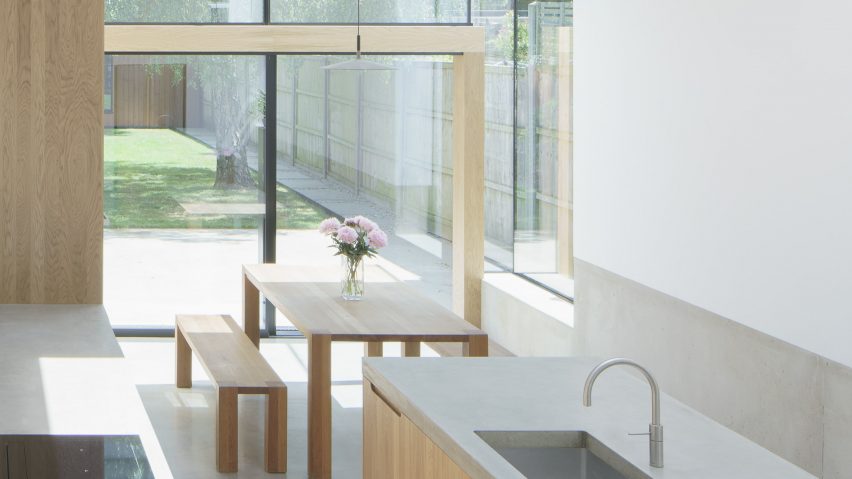A minimal material palette helps define this glazed extension, which London studio DHaus has added to the back of a house in Hertfordshire, UK.
Designed to help connect the home to its garden, the extension was designed to turn a house that suffered from dark and small spaces into a light-filled home with glass walls that frame views of nature.
The addition comprises a largely glazed extension as well as a separate studio, which sits at the end of the garden and contains a home gym.
"The fundamental concept was to frame the tree and garden with a new flush kitchen floor that was the same height as the garden level," DHaus co-director David Ben-Grunberg told Dezeen. "We were interested in creating heavy sculptural forms in a limited material palette with three main elements of concrete, timber and glass."
Connected to the rest of the home by a set of wooden stairs that run alongside a curving white panelled wall, the extension houses a kitchen and dining area that replaces the home's previous kitchen, which was dark and lacked space.
To enhance its connection to the garden, DHaus dropped the extension by one metre to place the new space at the same level as the back garden.
"The existing kitchen was dark and not large enough for a dining space. we wanted to create a light-filled space with a direct link to the outdoors," said Ben-Grunberg.
"The existing rear of the house was cut off from the garden as the main house was set one metre higher than the garden," he continued. "We dropped the finished floor level to the garden as the existing house was set much higher than the garden creating a disconnect between the two."
Aiming to create a more spacious zone in the house and invite natural light into its interior, the studio contained the extension within glass walls, keeping timber and concrete portions to a minimum and using frameless glass where possible to offer uninterrupted views of the garden outside.
"We wanted to frame views of the sky with a window box more akin to sculpture, to frame the beautiful east-facing garden and the large Birch Tree," said Ben-Grunberg.
Aside from the large portions of glazing, accents of timber and concrete feature throughout the additional space, including a low concrete datum that runs around the border of the extension and doubles as a bench in the dining area.
A concrete wall was built at one side of the facade, which runs up to the gate marking the edge of the site. To give the home a raw feel, a concrete floor extends from the extension's interior into the space outside, creating an outdoor terrace that borders the garden.
Inside, Douglas Fir timber was used for as many of the elements as possible, including the joinery, kitchen doors and exposed beams, which stretch along the length of the ceiling, interrupted by a skylight that offers additional natural lighting.
A series of Douglas-Fir furnishings topped with concrete worktops were arranged throughout the space, offering areas for dining and cooking as well as casual seating areas.
As well as the extension, DHaus added a separate studio building to the end of the garden, which houses a gym. Designed to reflect the design of the extension, the garden studio takes cues from the neighbouring structure's material palette while featuring raw finishes that give the building a more unfinished character.
"The gym was designed to mirror the language of the larger house extension with a raw exposed palette of blockwork and exposed timber ceilings and reveals," said Ben-Grunberg.
"With the twist being to be as raw and exposed as possible, the internal finish is just raw concrete blockwork, and we feel it works well for a gym space."
Other extensions that use large portions of glazing to brighten existing homes include an all-marble extension that features bright white surfaces and glass doors and a glass extension that refreshes a century-old cabin in the Czech Republic.
The photography is by Nick Dearden.

